 |
3R-INFO-BULLETIN 22
January 2003
The Author
 |
The project was headed by Vera Baumans, Professor of Laboratory Animal Science at the Karolinska Institute, Stockholm, and Animal Welfare Officer at Utrecht University. Her research interests are focussed on the housing, behaviour and wellbeing of laboratory animals.
Co workers in her project were: H. Augustsson, Comparative Physiology and Medicine, Swedish University of Agricultural Sciences, Uppsala, Sweden; H.A. van de Weerd, Department of Agriculture, University of Newcastle, UK ; C. L. J. J. Kruitwagen, Center for Biostatistics, Department of Laboratory Animal Science, Utrecht University, The Netherlands.
Current address:
Vera Baumans
vera.baumans@admin.ki.se
Veterinary Resources
Karolinska Institutet
17177 Stockholm
Sweden
Editor
Peter Maier, Scientific Adviser of the 3R Research Foundation
Environmental enrichment does not affect the variability of animal experimentation data in the Light/Dark test.
Crucial: The statistical treatment of experimental data
Several different statistical methods have been used previously to compare the effects of different types of environmental enrichment on variation in experimental results: the coefficient of variation (CV), mean absolute deviation (MAD) and sample size needed to obtain a pre-specified power (SS). We decided to first compare these three methods (MAD, CV, SS), to see whether the choice of method could influence the outcome and interpretation of the extent of variation. This would then give us a solid basis upon which to analyse and compare our results with those in the literature.
Behavioural pharmacology of anxiety
Several animal models have been developed to facilitate pre-clinical research on the behavioural pharmacology of anxiety. One of those models, which we chose for the present study, is the Light/Dark test (LD). The paradigm used in the LD test is the conflict between leaving a familiar dark (safe) area to explore a non-familiar brightly lit (unsafe) area. Benzodiazepine compounds such as diazepam are known to be potent anxiolytic (anxiety-reducing) drugs and are therefore commonly used as a reference drug when validating new compounds or tests of anxiety. In the LD test, mice given benzodiazepines cross over to the brightly lit area more quickly and more often, and spend more time there than do control mice. These results are dose-dependent (1).
The aim of the present project was to discover the effects of environmental enrichment on experimental results and on the variability of behaviour of mice given the same dose of benzodiazepam (intra-group variability) in the Light/Dark paradigm. The effects on general parameters such as body weight and food/water intake were also monitored. Two commonly used strains of laboratory mice (BALB/c and C57BL/6) were used in this study. These strains were previously used to validate the enrichment factors included in this study. The magnitude of the interstrain variation in experimental results served as the reference value.
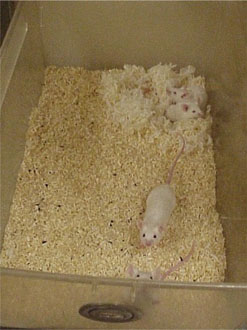 Fig. 1a: sawdust only (NE) | 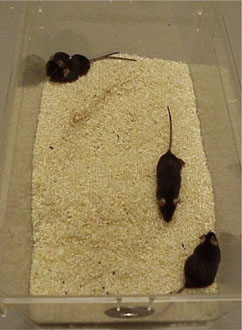 Fig. 1b: nesting material (E) | 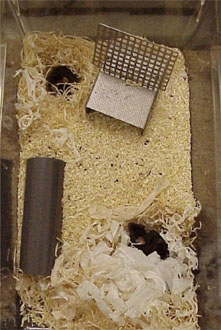 Fig. 1c: nest-box, clim-bing grid, nesting material, wooden gnawing stick and PVC tube (SE). |
Environmental enrichment, the experimental set-up1
The behaviour of 216 naive adult male mice of two different strains (C57BL/6JOlaHsd and BALB/cOlaHsd) and their response to benzodiazepam was studied (n=12 per treatment group). The animals were housed in groups of four in cages that were either non-enriched (NE, Fig. 1a), enriched (E, Fig. 1b) or super-enriched (SE, Fig. 1c) cages. Bodyweight, food and water intake were recorded once a week. After 5 weeks the animals were randomly assigned to one of three treatments: control (no injection), sham (saline injection i.p.) or diazepam (1mg/kg bw i.p) and tested in the Light/Dark test (Fig. 2) for 5 minutes.
The latency time before the animal entered the light compartment, the number of tunnel crossings and the amount of time spent in the light compartment were scored manually from video recordings using the behavioural observation software package THE OBSERVERTM (Noldus Information Technology, Wageningen, NL). The total distance each mouse travelled, the animal’s speed, and the amount of time the animal spent moving or still were recorded automatically using a Laboratory Animal Behaviour Observation, Registration and Analysis System (LABORASTM Metris, Hoofddorp, NL) (Fig 2).
Data were analysed using S-PLUS 2000 Professional Release 3 (MathSoft Inc.). To analyse whether the experimental factors (housing, strain and treatment) influenced the variation of our variables of interest we quantified the variation within each of the housing conditions in three different ways: using coefficient of variation (CV), mean absolute deviation (MAD) and Power Analysis (SS).
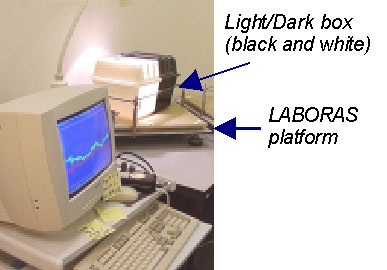
Fig. 2: Light/Dark test set up.
The mouse strain determines behaviour and response
The control C57BL/6 mice scored higher than BALB/c mice in activity related measurements (p<0.05-0.001) and had a naturally less “anxious” behaviour profile (shorter latency period) in the Light/Dark test (Fig. 3). The anxiolytic effect of diazepam was generally clear in BALB/c mice but absent in C57BL/6 mice (p<0.01). Thus the mouse strain was the factor responsible for the greatest difference in experimental results.
Enriching the environments of the mice produced no significant difference in either the mean or the intra-group variation of experimental results in any of the behavioural parameters measured. However, the interpretation within-group variability did depend slightly on the choice of statistical method used to analyse variation.
Environmental enrichment does not necessarily require more animals.
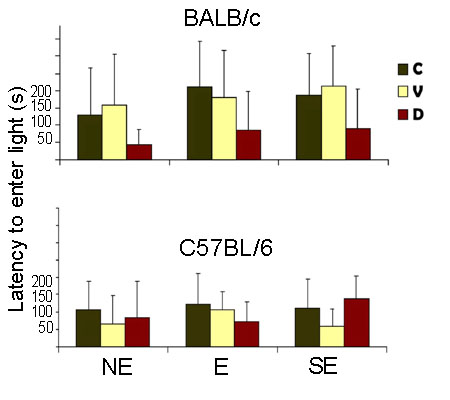
Fig. 3:: Latency to enter lit compartment. Comparison between strains, housing and pharmacological treatments (C=control, V=vehicle, D=diazepam).
Since environmental enrichment neither affected the outcome of behavioural results, nor produced an increase in variation in experimental results, there is no scientific basis for not adding enrichment factors to the cages of rodents in this kind of study. Enriching the animals’ environment does not mean that more animals will be required to obtain statistically significant results. Indeed, the beneficial influence of enrichment factors on animal welfare has been well established, and it is to be hoped that this practice will become standard in the near future.
References:
- Baumans V, (1997) Environmental enrichment: practical applications., In: Animal Alternatives, Welfare and Ethics (LMF Van Zutphen and Balls M, eds). Elsevier Science BV. pp 187-191.
- Eskola S, Lauhikari M, Voipio H-M, Laitinen M and Nevalainen T. (1999) Environmental enrichment may alter the number of rats needed to achieve statistical significance. Scandinavian Journal of Laboratory Animal Science 26, 134-14.
- Mering S, Kaliste-Korhonen E and Nevalainen T. (2001) Estimates of appropriate number of rats: interaction with housing environment. Lab Anim 35,80-90.
- Van de Weerd HA, Aarsen EL, Mulder A, Kruitwagen CLJJ, Hendriksen CFM and Baumans V. (2002) Effects of environmental enrichment for mice on variation in experimental results. Journal of Applied Animal Welfare Science 5, 87-108.
1:
Environmental enrichment and variation in experimental results
Current housing systems for laboratory rodents are characterised by a constant, controlled and standardised environment, based primarily on economic criteria and ergonomic factors for the personnel caring for the animals. However, such environments lack most of the structural features and the complexity of the rodents’ natural habitat, resulting in boredom and potentially detrimental effects on the animals’ welfare.
One of the possibilities to improve housing conditions of laboratory animals is to provide opportunities for the animals to perform a more species-specific behavioural repertoire. This is done by providing so-called “environmental enrichment”. If the animal can behave naturally, its ability to cope with and control environmental stress factors is thought to increase. Reduced stress should in-crease the animals’ welfare. Numerous studies have investigated the potential benefits of different types of environmental enrichment for laboratory mice. These include i) the expression of a more species-specific behaviour, ii) enhanced learning abilities and iii) prevention of stereotypic behaviour patterns. Accordingly the use of enrichment is generally recommended in guidelines for laboratory rodents.
Although the benefits of environmental enrichment on animal welfare are undisputed, concern has been raised that introducing enrichment into the standardised cages of laboratory animals may increase the within-group variability of experimental results, thus requiring an larger number of animals to produce statistically significant data. Such a consequence would of course be counter-productive to animal welfare concerns. To date, contradictory results have been reported, some showing an increase, others a decrease, and still other unchanged within-group variability in animals living in enriched environments (2; 3; 4).
| Dernières modifications: 30.01.2008 |